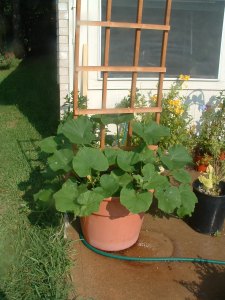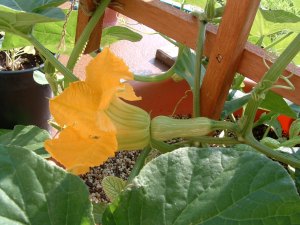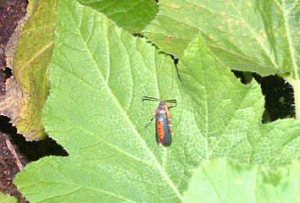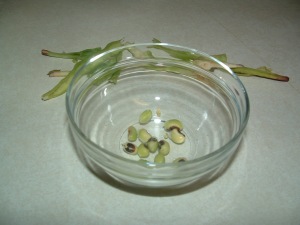
Them's some big squash leaves thare . . .
Wow, now if only the squash fruit gets just as big, I’ll have a fab crop of B-nut squash! I am so happy to report that after my failed first go-round with planting butternut squash in a large container earlier this summer, I’ve now got vines out the wazoo, with big, healthy leaves and lots of big healthy baby squash and squash blossums. It is truly amazing what some good fertilizer and vigilance will do!
It was really heartbreaking earlier when I first planted the squash seeds from an organic butternut squash I’d bought at Whole Paycheck, I mean, Whole Foods earlier this spring. It started out so beautifully. I got it on the trellis, and it started popping out some little baby squash, but then it started getting yellow in places, and some of the squash started shriveling up. It reminded me of the disappointing venture I had last year at the apartment when I tried to grow some container cukes. They did the same thing, and I’d thought then it was disease. But nope, turns out that the likely culprit of both devastations was a mean little critter called a squash vine borer.
Late at night and early in the morning these little pests land on the curb family (I’m using the abbreviation cuz I don’t think I can spell the proper name without having to look it up, which I’m too lazy to do), which includes all squashes and cukes, lays little dark eggs at the base of the plant, and when the eggs hatch, evil little larvae burrow into the plant, suck it dry and then crawl into the soil to mature. This bore (no pun intended) itself out when I pinched back a dying baby squash to find a groddy little larvae high-tailing it into the stem, hoping I didn’t see it — but I did. Then as I did research, I realized that the little dark specks I’d seen earlier on the stems were the eggs- wish I’d realized it then. I had no idea. And I’m certain this is what destroyed my cukes last year — the vines grew, and little cukes would come out, but they’d wither away before they had a chance to grow. And that was what was happening to my beloved butternut squash plant.
So with a heavy heart, I yanked them out of the container, grabbed a couple more seeds, let them soak in water about 30 minutes, and planted them again. I was determined to have me some B-nut squash this fall! This time I didn’t shield them from the sun, and this time they popped up, I think even faster than the other ones did. And man, did they grow fast! They were growing fast even before I decided to put some organic fertilizer I’d inherited from my next-door apartment neighbor when she moved.
And then boy, did they explode! The leaves got huge, and so did the budding squash blossums. I’d decided to add fertilizer, because I kept reading that the healthier your plants, the more resistant they are to pest and disease. Now, don’t tell ol’ Mel B ( of SFG fame, not the Spice Girl) that I did that, cuz he feels that if you’ve got good compost, you shouldn’t need fertilizer. Now the compost I used in the container was some I’d had left that I’d bought from Whole Foods last year, and not the really great LadyBug Compost, which I used with the malabar spinach in my tiny SFG to great success. So ol’ Mel can rest assured that great compost gets you great healthy plants, while not-so great compost gets you so-so results. When ya got not-so-great compost, ya add some great organic fertilizer.
In any case, the fertilizer I used seemed to do the trick. Green, green vines and humongous green leaves,

Beauty-ful yellow squash blossum & healthy baby squash
huge yellow beautiful yellow squash blossums and healthy baby fruit (see pic, right), and so far it seems, no infestation of squash vine borer! I have also made garlic tea and sprayed it periodically on the whole plant, which seems also to help a lot. I had to go out of town for a few days last week and contemplated putting row cover over it to protect it while I was gone, but I didn’t want my cat sitter to have to deal with removing it to water, so I let it go. The plant was still very, very healty when I got home, and the baby squash looks very healthy and is getting bigger by the day.
I had a little bit of a scare when I saw one of the squash looking a little withered, and I decided to go ahead and remove it, open it up and see if there was any larvae. I couldn’t find any. There may have been a squash bug (also known as stink bugs) that sucked on it. Those are a different sort of pesky squash critter that munch on the outside, as oppose to the inside, of squash. I also found on the backs of the leaves some patches of what looked like squash bug eggs. I sprayed the vine with garlic spray, and did my best to remove as many of the eggs off the leaves as I could. The vines weren’t that infested, and the eggs come of very easy and seemed to be destroyed just by rubbing them off the leaf. I will continue to be vigilant however, and look to have a successful crop this fall.
My next challenge, I think, will be managing the vines. Like the last time, I let both vines from each seed grow, even though Mel and the literature tell you to remove one of them. I just couldn’t do it. So now I gotta a lotta vine. Eventually, I may have to remove one, but I hope I can grow them both without too much trouble. But the vines are just growing like mad, and I’m not sure the trellis I have will be big enough. Then I’ll have to figure out how to support the squash fruit themselves on the trellis as they get bigger. I’ve read that if you’re trellising squash you can support the fruit with pantyhose(!), but I’m concerned that I’m going to have so much squash that there won’t be enough room to support them all on the trellis! It may just look like one big pantyhose convention as it is! Not that I’m complaining — I love butternut squash, and will be happy if I can grow a ton of it. It would be nice, however, if I could find pix of butternut squash, or other big winter squash growing on a trellis to see what others are doing. I also wonder if the vines can be trimmed? I need to find that out as well. If any of you readers know, please, pretty please with squash on top, leave me a comment below.
It does excite me, in my little B-nut squash experience that thus far: 1) I’ve been able to grow big, healthy vines from seed I saved from organic produce I bought and 2) that I’ve been able thus far to grow it in a container. When I started out in this experiment, I couldn’t find much on how to grow one in a container, only that it might be possible with a large container. Also, I wanted to do this as much for others who can only grow things in containers, like apartment or condo dwellers, or those who can’t bend down to garden, as much as for me, and I want others to see that you don’t need yardage to grow veggies and fruits.
Before I even got the house, I aspired to become self-sufficient even in an apartment, and my original idea and goal was to show how anyone, anywhere, can become self-sufficient. I had already started to do some container gardening at my apartment, and was looking to expand further. The house came to me as an unexpected blessing and surprise, and enabled me to expand my horizons to urban farming in an urban backyard, utilizing square foot gardening, and perhaps other methods, like lasagna gardening, and Mittlieder gardening that I hope to experiment with later. But, partly because I wasn’t ready to do full-on-out urban gardening and SFG, and partly because I wanted to help those who can only do container gardening, I decided to do things like try to grow butternut squash and black-eyed peas from seeds saved from organic produce at the store in containers, and grow malabar spinach and fruit (like dwarf pomegranate, blueberries and goji berries) in containers, along with my SFG experiment with the other malabar spinach plant and basil.
In any case, I hope that as I experiment others can learn from what I am doing and become inspired to do some gardening, and even become more self-sufficient, as I am doing. Right now we are living in some challenging times economically, environmentally, health-wise, etc., but these challenges are providing us with some really fab opportunities. More people are taking up urban farming and learning to rely less on the grocery store and more on themselves, while saving money, the environment, their health, and heck, maybe even their souls! I know that it has given me a wonderful passion that has enriched my own life and soul, and that I know will continue to deepen as I garden more and more and do more things to become self-sufficient. I am excited about this little adventure that I am on, and I hope you get inspired to embark on your own!
Ah-hum . . . well, guess I got a little carried away there. But, to partially quote one of our former local deli owners in a commercial he did for years and years — I just can’t help it! I gotta tell ya!
And now, inspiring speech over, I gotta go to bed! 😉
Read Full Post »







